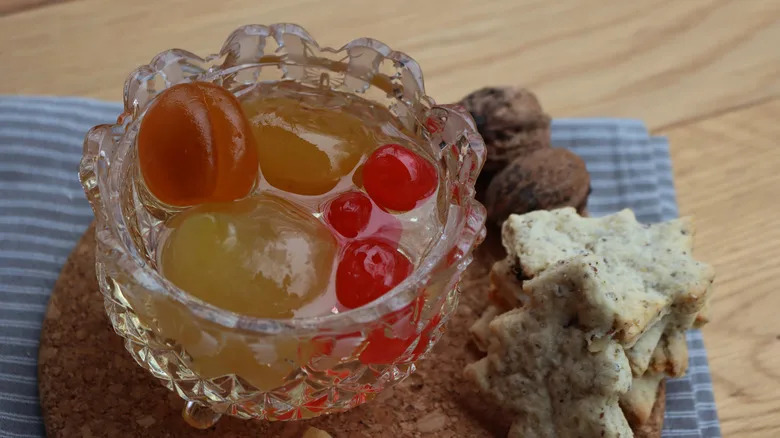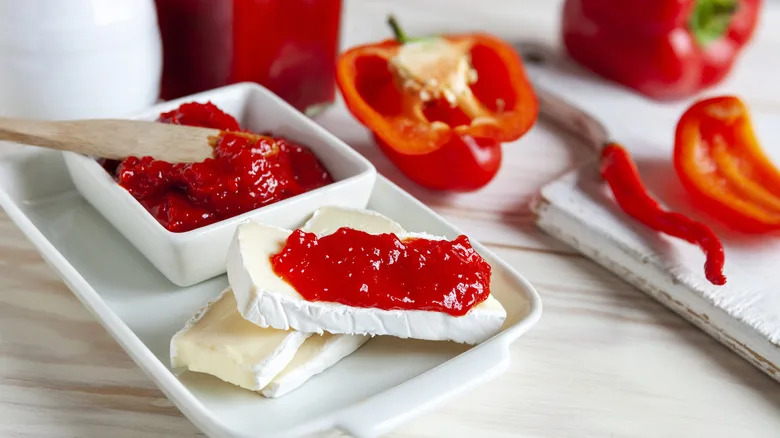Regarding matters of Italian cuisine, few figures stand out more than Giada De Laurentiis. The chef, author, and TV personality is perhaps best known for her presence on The Food Network. Her 2003 series “Everyday Italian” introduced many home cooks to the art of Italian cooking, and she has made an art of incorporating a “dolce vita” approach to almost any dish. And yes, that includes to the entertaining go-to of charcuterie. By now, charcuterie boards are all but expected at gatherings both big and small. The spread of meats, cheeses, sauces, spreads, pickles, and breads is a delicious, of course. But certain charcuterie ingredients can also be a bit boring (yes, salami and gouda on a cracker is delicious, but it’s hardly thrilling). Luckily, Giada De Laurentiis has just the think to perk up your charcuterie board –– and it’s tangier than you might think.
According to an Instagram post made by Giadzy, the chef’s lifestyle site, “Your cheese boards and antipasti platters need an equally bright condiment: mostarda.” So what is mostarda? Well, mostarda is a relatively broad term, which can encompass a number of ingredients and flavor profiles. Broadly speaking, mostarda is a condiment made with candied fruit that is stored in a syrup with spices and mustard seeds and mustard oil. The condiment is sweet, tangy, and spicy. Simply put: It’s just what your next charcuterie board is missing. Its sweetness and mustardy edge make it the perfect accompaniment to rich, salty cheeses and meats. Adding it to your next charcuterie can bring the dish to a whole new level, you just need to know what kind of mostarda to choose (or make).
Read more: The Kitchen Organization Tool We Never Thought To Use In The Fridge (But It Makes So Much Sense)
The Many Faces Of Mostarda
Cup of mostarda with crackers on a wooden table – Saratm/Getty Images
The great thing about mostarda is that there is no one, definitive version of the dish. Tthere are three main types of mostarda. First, there is Venetian mostarda, aka mostarda Veneta, which uses fruit that has been blended or purred until smooth. It has a texture similar to a jam, and makes a great spread for sandwiches. Then, there is mostarda di Mantova, which is chunkier, closer to a chutney, and is made of chopped pieces of one type of fruit, such as apricots or pears. Mostarda di Cremona, which is most common in Northern Italy, is made with several kinds of fruit that are served whole and unsliced. It is often served during Christmas, and is often accompanied by meats and cheeses.
There are several ways to go about making mostarda, with varying levels of difficulty and time frames. Usually mostarda takes several days to come together, as it is made by soaking candied or dried fruits in syrup, draining, and reducing over the course of several days. Often, these fruits are soaked in alcohol beforehand, and sometimes spices and vinegar is also incorporated. Mustard seeds or mustard seed oil is also a must, giving the spread its distinctive, spicy taste. If you want to make a mostarda but are on a time crunch, you can also use Giada De Laurentiis’ method of making a quick batch by combining dried fruits with aromatic ingredients and sautéing with vinegar, mustard, sugar, salt, and other spices until the flavors have suffused and the spread has taken on a sweet, picante taste that is sure to perk up any cheese board.
Other Ways To Serve Up The Sweet And Tangy Delight
Pepper mostarda on cheese – Eleonora Grigorjeva/Getty Images
Any charcuterie assembler worth their salami knows that making these massive spreads is more than just tossing some cold cuts on a board with whatever cheese slices you happen to have on hand. It’s an art, a craft finely honed by understanding the intricate interplay of flavors that form the best possible bite. Mostarda makes a wonderful addition to most charcuterie boards, yes, but it’s also important to choose the best cheese for your mostarda, and the best mostarda for your cheese. One way you can pair you mostarda is by its fruit base. For example, if you’re using a mostarda with an apricot base, a great pairing would be goat cheese (just make sure your goat cheese hasn’t gone bad). A nice, creamy, tangy chevre would go excellently with the fresh, sweet, peachy taste of your apricot. Plus, the spice of the mustard oil and seed will give this pairing a wonderful kick. You can also try a cranberry mostarda for your winter holiday charcuterie spread.
If you’re using a mostarda made with a more tart, berry like flavor, such as currants, pairing with a creamy cheese such as brie would work well to contrast its sharp flavor. Additionally, a grape mostarda would go well with the earthy taste of blue cheese. However, there are no hard and fast rules, so you pair your mostarda as you please, you might be surprised at how delicious this one, humble condiment can be.
Read the original article on Chowhound.


Dining and Cooking